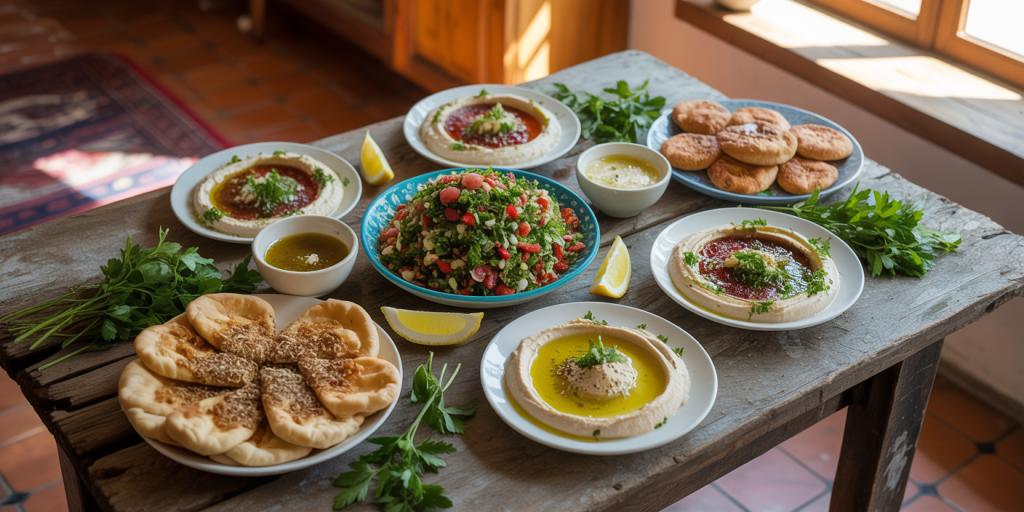Lebanese cuisine stands as one of the most celebrated and cherished culinary traditions in the world, boasting a rich history woven with vibrant flavors, fresh ingredients, and time-tested techniques. From the bustling streets of Beirut to the family kitchens scattered across the Middle East and diaspora communities worldwide, Lebanese dishes offer a blend of nourishment, social bonding, and cultural pride.
In recent years, the enthusiasm for homemade Lebanese food has grown exponentially. Many home cooks seek to recreate authentic meals that not only satisfy the palate but also preserve heritage and foster connections across generations. This article explores some of the most beloved homemade Lebanese favorites, delving into their origins, preparation methods, and nutritional benefits, while also highlighting practical tips and comparative insights for enhancing your culinary repertoire.
—
The Essence of Lebanese Homemade Cooking
Lebanese homemade cooking is characterized by its emphasis on freshness, balance, and simplicity. Traditional recipes often revolve around seasonal vegetables, grains like bulgur and rice, aromatic herbs, and healthy fats such as olive oil. The popularity of mezze—small plates featuring an assortment of dips and salads—reflects the cultural significance of sharing meals with family and friends.


For example, the iconic dish of *tabbouleh* combines bulgur wheat, parsley, mint, tomatoes, and lemon juice, resulting in a refreshing and nutrient-rich salad ideal for any table setting. Lebanese home cooks often prepare it in large batches, balancing flavors with generous amounts of fresh herbs and a perfect citrus tang, which can be adjusted to personal taste.
Another staple is *hummus*, a creamy chickpea dip that is both versatile and highly nutritious. The homemade version typically outshines store-bought alternatives by its fresh texture and customizable seasoning levels. Provenance adds to the experience; preparing these familiar dishes by hand allows cooks to control ingredient quality and adhere to dietary preferences, making Lebanese homemade cooking a highly rewarding endeavor.
—
Essential Homemade Lebanese Dishes and Their Preparation
1. Manakish: The Lebanese Flatbread Delight
Manakish, often dubbed the “Lebanese pizza,” is a popular homemade flatbread baked with toppings such as za’atar (a blend of thyme, sesame, and sumac), cheese, or ground meat. Historically, this dish was a staple breakfast item in Lebanese households.
Making manakish at home provides control over ingredient freshness, especially the dough’s yeast fermentation, which is crucial for its light texture. Home cooks typically use simple pantry ingredients: flour, water, olive oil, and salt for the dough, paired with freshly ground za’atar or locally sourced cheese variants.
A comparative table illustrates variations:
| Manakish Type | Key Ingredients | Preparation Time | Typical Serving Occasion |
|---|---|---|---|
| Za’atar Manakish | Flour, za’atar, olive oil | 30-45 minutes | Breakfast or snack |
| Cheese Manakish | Flour, akkawi or mozzarella | 45-60 minutes | Breakfast, snack, or dinner |
| Meat Manakish | Flour, minced lamb/beef, spices | 60-90 minutes | Lunch or dinner |
According to a 2021 culinary survey by the Lebanese Ministry of Culture, homemade manakish remains a household favorite, with 75% of respondents cooking it weekly. Its adaptability makes it approachable for beginner cooks, yet offers complexity for seasoned chefs experimenting with regional toppings.
2. Kibbeh: The Quintessential Meat Dish
Kibbeh is arguably Lebanon’s most famous national dish, combining ground lamb or beef with bulgur wheat and spices in a unique fusion of textures and flavors. It appears in various forms—fried, baked, or served raw as *kibbeh nayyeh*.
The homemade preparation of kibbeh involves soaking bulgur and finely chopping meat to achieve a cohesive dough-like mixture. Cooks often experiment with spice ratios, incorporating cinnamon, allspice, or nutmeg to suit family tastes. The most traditional method includes stuffing the bulgur shell with a savory filling of sautéed onions, pine nuts, and ground meat.
Practical case studies from Lebanese home cooks reveal that preparing kibbeh at home deepens cultural ties; elders often teach younger generations the intricacies of meat grinding, dough kneading, and proper seasoning—a process that fosters communal bonding.
Nutrition-wise, kibbeh balances protein with complex carbohydrates. The USDA reports that a 150-gram serving of kibbeh contains approximately 280 calories, 18g protein, 12g fat, and 20g carbohydrates, making it a wholesome choice within a balanced diet.
—
The Nutritional Impact of Lebanese Homemade Cuisine
Lebanese cuisine’s reputation as one of the healthiest in the Mediterranean basin is well-founded. A 2018 study published by the American Journal of Clinical Nutrition found that traditional Lebanese diets, abundant in vegetables, legumes, olive oil, and lean meats, contribute to lower rates of cardiovascular disease and obesity compared to Western diets.
Homemade cooking amplifies these health benefits by minimizing processed ingredients and excessive sodium. For instance, preparing *mujaddara*—a simple yet hearty dish combining lentils, rice, and caramelized onions—at home ensures control over ingredient quality and flavor intensity, avoiding stored preservatives or flavor enhancers.
Comparative nutritional data between homemade Lebanese dishes and commercial fast food illustrate stark contrasts:
| Dish | Calories (per serving) | Sodium (mg) | Fat (g) | Preparation Method |
|---|---|---|---|---|
| Homemade Mujaddara | 350 | 250 | 5 | Ingredients cooked fresh at home |
| Fast Food Burger | 550 | 900 | 30 | Processed, high sodium and fat |
| Homemade Hummus | 150 | 200 | 6 | Freshly blended chickpeas and tahini |
| Store-bought Hummus | 180 | 350 | 10 | Preserved with additives |
This data supports why many Lebanese families emphasize homemade preparations, aligning taste preferences with better health outcomes.
—
Traditional Lebanese Sweets Made at Home
No Lebanese feast is complete without *ma’amoul* or *knafeh*, two sweet delicacies that capture the dessert lover’s heart. Ma’amoul are semolina cookies filled with dates, nuts, or figs, traditionally baked during festive occasions like Eid or Easter.

Making ma’amoul involves mastering dough consistency and mastering the iconic patterns used for shaping. According to a 2020 survey of Lebanese households, 60% of families prepare ma’amoul at home around holidays, underscoring its cultural significance.
Knafeh, on the other hand, is a rich cheese pastry soaked in fragrant sugar syrup and topped with crushed pistachios. Homemade knafeh often relies on fresh akkawi or nabulsi cheese and hand-pulled kataifi dough, which many find to vastly improve texture over mass-produced alternatives.
These sweets highlight the intersection between culinary art and tradition, where the act of creation itself fosters familial warmth and memory-making.
—
Practical Tips for Mastering Lebanese Cooking at Home
To excel in Lebanese homemade cooking, several practical steps are recommended:
1. Ingredient Sourcing: Prioritize fresh, high-quality ingredients. Local markets, Mediterranean specialty stores, and online vendors often carry authentic products like Lebanese olive oils, za’atar blends, and fresh herbs.
2. Preparation Techniques: Invest time in mastering foundational techniques such as dough fermentation for manakish, soaking and washing bulgur for tabbouleh and kibbeh, and proper chickpea cooking for hummus.
3. Balancing Flavors: Lebanese cuisine thrives on a harmony between acidity, saltiness, and aromatic herbs. Learning to adjust lemon juice, salt, and sumac levels can elevate dishes significantly.
Home cook Amira Haddad from Tripoli shares, “Making Lebanese dishes at home connects me to my roots while giving me freedom to innovate. The process is rewarding; when my children learn these recipes, our family traditions continue.”
—
Looking Ahead: The Future of Homemade Lebanese Favorites
As global interest in Mediterranean diets grows, Lebanese homemade cooking stands poised for renewed appreciation and innovation. The rise of culinary apps, social media platforms, and global ingredient accessibility has made traditional recipes more approachable for international audiences.
Future trends may include: Health-Conscious Adaptations: More home cooks may substitute ingredients to lower calories or introduce plant-based proteins while preserving authentic flavors. Technological Integration: Smart kitchen devices could facilitate fermentation, dough rising, and precise spice blending, helping novices achieve professional results. Cultural Fusion: Lebanese homemade favorites may merge with other culinary traditions, fostering creative hybrids without losing cultural integrity.
Research from the Lebanese Gastronomy Foundation indicates a 35% increase in young adults engaging with traditional recipes via digital media since 2019, indicating growing intergenerational interest.
Moreover, home cooking centers and workshops focusing on Lebanese cuisine are expanding globally, reinforcing culinary education and cultural exchange.
In conclusion, homemade Lebanese favorites embody more than nourishment—they represent identity, community, and history. Embracing these recipes with authenticity and creativity ensures their legacy endures for generations to come.

Deixe um comentário